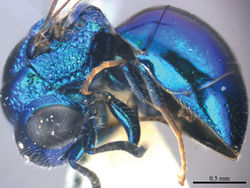Omalus imbecillus
| Notice: | This page is derived from the original publication listed below, whose author(s) should always be credited. Further contributors may edit and improve the content of this page and, consequently, need to be credited as well (see page history). Any assessment of factual correctness requires a careful review of the original article as well as of subsequent contributions.
If you are uncertain whether your planned contribution is correct or not, we suggest that you use the associated discussion page instead of editing the page directly. This page should be cited as follows (rationale):
Citation formats to copy and paste
BibTeX: @article{Wei2014ZooKeys407, RIS/ Endnote: TY - JOUR Wikipedia/ Citizendium: <ref name="Wei2014ZooKeys407">{{Citation See also the citation download page at the journal. |
Genus: Omalus
Name
Omalus imbecillus (Mocsáry, 1889) (new to China) – Wikispecies link – Pensoft Profile
- Ellampus imbecillus Mocsáry, 1889: 98.
- Holophris imbecillus (Mocsáry, 1889): Kimsey and Bohart 1991[1]: 225.
- Omalus imbecillus (Mocsáry, 1889): Rosa 2005[2]: 12.
Material examined
Lectotype: 1 ♀ (HNHM), “Turkestan”, “imbecillus Mocs, type, det. Mocsáry”, “Lectotypus, Ellampus imbecillus, ♀, (L. D. French), Mocsáry”, “id nr. 135046, HNHM, Hym. coll.”. Other material: 3 ♀♀ (HNHM), Laos, Vientiane, 19.III.1990, E. Kondorosy; 1 ♀ (SCAU), Yunnan, Kaiyuannan River (23°42'N, 103°16'E ), 16.VII.2003, Long Hu, No. 20048184; 1 ♀ (SCAU), Yunnan, Gaoligongshan National Nature Reserve (25°50'23"N, 98°51'23"E), 16–17.VII.2006, Jie Zeng, Juan-juan Ma, and Bin Xiao, No. SCAU-O0038.
Diagnosis
Scutellum with two flattened and semi-elliptical foveae on anterior margin, with numerous fine, short, longitudinal striae on posterior margin. Propodeal angle indistinct. Apex of T-III with narrow, colourless semi-transparent rim, without medial notch.
Description
Described from a female from Yunnan. Body length 3.3 mm (Plate 9). Forewing length 2.6 mm. MS = 1.0 MOD. Head. Face with large, round, dense (0–0.5 PD), shallow punctures (Plate 10A). Scapal basin deep, smooth, glabrous (Plate 10A). Ocellar triangle isosceles. Postocellar line very weak, broadly interrupted medially (Plate 10B). Gena with distinct, oblique wrinkles. Mesosoma. Pronotum impunctate medially, with small, deep pits on anterior margin; with large, dense (0–0.5 PD) punctures laterally (Plate 10B). Mesoscutum polished, impunctate (Plate 10D); notauli indistinct but complete, impressed as fine lines, with notaulic pit oval; parapsidal lines indistinct (Plate 10D). Scutellum with two flattened, semi-elliptical foveae on anterior margin (Plate 10D); with triangular, impunctate area antero-medially (Plate 10D); with numerous fine, short, longitudinal striae on posterior margin; with deep punctures, becoming larger towards alar foveae (Plate 10D); Mesopleuron without striae between punctures (Plate 10C). Metanotum gibbous, with large, deep, areolate-reticulate punctures (Plate 10D). Propodeum with lateral margin very slightly concave before propodeal angle; propodeal angle indistinct. Tarsal claw with three teeth.
Metasoma. Oval (Plate 10E), L/W = 15/11. T-I and T-II almost impunctate. T-III with fine, scattered punctures (Plate 10E); apex of T-III with narrow (1/3 MOD), colourless semi-transparent rim, without median notch (Plate 10F).
Colouration. Face metallic green. Head and mesosoma metallic blue, with purple reflections on vertex, median pronotum, and mesoscutum. Antenna black, with scape and pedicel metallic greenish-blue. Tegula metallic blue. Leg metallic greenish-blue, with tarsus brown. Metasoma purple, with metallic blue.
Variation. Female (n = 6). Body length 3.3–3.9 mm. Forewing length 2.6–3.2 mm.
Male. Chinese male specimens are not available for this study.
Distribution
China (Yunnan), Laos, Russia, Turkey, Iran (Kimsey and Bohart 1991[1]; Rosa et al. 2013[3]).
Biology
Unknown. Collected in March and July.
Taxon Treatment
- Wei, N; Rosa, P; Liu, J; Xu, Z; 2014: The genus Omalus Panzer, 1801 (Hymenoptera, Chrysididae) from China, with descriptions of four new species ZooKeys, 407: 29-54. doi
Other References
- ↑ 1.0 1.1 Kimsey L, Bohart R (1991) The Chrysidid Wasp of the World. Oxford University Press, New York, 652 pp.
- ↑ Rosa P (2005) I Crisidi (Hymenoptera, Chrysididae) del Museo Civico di Storia Naturale di Milano. Natura, Milano, 128 pp.
- ↑ Rosa P, Lotfalizadeh H, Pourrafei L (2013) First checklist of the chrysidid wasps (Hymenoptera: Chrysididae) of Iran. Zootaxa 3700(1): 1-47. doi: 10.11646/zootaxa.3700.1.1
Images
|

